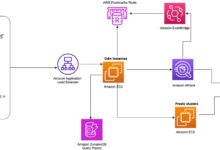AWS SageMaker: 7 Powerful Reasons to Use This Ultimate ML Tool
Ever wondered how companies like Netflix or Uber build smart AI models at scale? The secret often lies in AWS SageMaker—a game-changing platform that simplifies machine learning for everyone from beginners to data science pros.
What Is AWS SageMaker and Why It Matters

AWS SageMaker is Amazon’s fully managed service that enables developers and data scientists to build, train, and deploy machine learning (ML) models quickly. It removes much of the heavy lifting traditionally involved in ML workflows, making AI development faster, more scalable, and accessible.
Core Definition and Purpose
At its heart, AWS SageMaker is designed to streamline the entire machine learning lifecycle. From data preparation to model deployment, it offers integrated tools that reduce the time it takes to go from idea to production.
- Eliminates the need to manage infrastructure manually
- Supports popular ML frameworks like TensorFlow, PyTorch, and Scikit-learn
- Enables collaboration between data engineers, scientists, and DevOps teams
“SageMaker allows you to focus on the model, not the machine.” — AWS Official Documentation
Who Uses AWS SageMaker?
The platform is used across industries by startups, enterprises, and research institutions. Whether you’re predicting customer churn, detecting fraud, or building recommendation engines, SageMaker provides the tools to do it efficiently.
- Financial institutions use it for real-time fraud detection
- Retailers leverage it for demand forecasting and personalization
- Healthcare organizations apply it to medical image analysis and diagnostics
Key Features of AWS SageMaker That Set It Apart
What makes AWS SageMaker stand out in a crowded ML platform market? Its comprehensive suite of tools that cover every stage of the ML pipeline. Let’s break down the most impactful features.
Studio: The All-in-One Development Environment
AWS SageMaker Studio is a web-based, visual interface where you can perform all ML development tasks. Think of it as an IDE (Integrated Development Environment) tailored specifically for machine learning.
- Write code, track experiments, debug models, and manage datasets in one place
- Real-time collaboration with team members using shared notebooks
- Integrated Git support for version control
You can access SageMaker Studio directly from your browser without installing any software—making onboarding seamless.
Autopilot: Automated Machine Learning Made Simple
Not everyone is a data scientist, and that’s where SageMaker Autopilot comes in. It automatically builds, trains, and tunes ML models based on your data—without requiring deep expertise.
- Upload a CSV file, and Autopilot handles feature engineering, algorithm selection, and hyperparameter tuning
- Generates a leaderboard of top-performing models with explanations
- Outputs clean, interpretable Python code for transparency
This feature is especially useful for business analysts or developers who want to experiment with ML but lack advanced statistics knowledge.
Ground Truth: High-Quality Labeled Data at Scale
One of the biggest bottlenecks in ML is getting accurately labeled training data. SageMaker Ground Truth helps you create high-quality labeled datasets using a mix of human annotators and machine learning.
- Supports image, text, video, and audio labeling
- Uses active learning to reduce labeling costs by up to 70%
- Integrates with Amazon Mechanical Turk or private workforce teams
For example, a self-driving car company can use Ground Truth to label thousands of road images for object detection models.
How AWS SageMaker Simplifies Model Training
Training ML models can be resource-intensive and complex. AWS SageMaker removes much of this complexity with managed training jobs, distributed computing, and built-in algorithms.
Managed Training Jobs with Full Control
With SageMaker, you don’t need to provision servers or manage clusters. You define your training job, specify the instance type, and SageMaker handles the rest—from spinning up instances to installing dependencies.
- Supports both built-in algorithms (like XGBoost, Linear Learner) and custom models
- Automatically scales compute resources based on workload
- Logs metrics to Amazon CloudWatch for monitoring
You can even pause and resume training jobs, which is helpful when working with large datasets.
Distributed Training for Large-Scale Models
For deep learning models that require massive computation, SageMaker supports distributed training across multiple GPUs or instances.
- Uses Horovod and other frameworks to split workloads efficiently
- Reduces training time from days to hours
- Supports data and model parallelism strategies
This capability is crucial for training large language models (LLMs) or computer vision systems used in industries like aerospace or genomics.
Built-in Algorithms for Faster Development
SageMaker includes a library of optimized, pre-built algorithms that are tuned for performance and scalability.
- Popular choices include K-Means, PCA, Object2Vec, and BlazingText
- These algorithms run faster than open-source equivalents due to AWS optimizations
- Can be used directly in notebooks or via API calls
For instance, a marketing team can use the built-in XGBoost algorithm to predict customer lifetime value without writing custom training code.
Deploying Models with AWS SageMaker: From Test to Production
Building a model is only half the battle. Deploying it reliably in production is where many ML projects fail. AWS SageMaker excels here with robust deployment options and monitoring tools.
One-Click Model Deployment
SageMaker allows you to deploy models with just a few lines of code. Once trained, a model can be deployed to a secure, scalable endpoint that serves real-time predictions.
- Endpoints automatically scale based on traffic (using Auto Scaling groups)
- Supports A/B testing by deploying multiple model versions
- Can be integrated with API Gateway and Lambda for serverless architectures
For example, a fintech app can deploy a credit risk model and serve predictions in under 100ms per request.
Batch Transform for Offline Inference
Not all predictions need to happen in real time. SageMaker’s Batch Transform feature lets you run inference on large datasets asynchronously.
- Process millions of records without setting up a persistent endpoint
- Cost-effective for periodic reporting or data enrichment
- Input and output data stored securely in Amazon S3
A retailer might use Batch Transform to score all customers for churn risk once a week and feed results into a CRM system.
Real-Time Inference with Low Latency
For applications requiring instant responses—like chatbots or fraud detection—SageMaker delivers low-latency, high-throughput inference.
- Uses Elastic Inference to attach GPU acceleration to CPU instances, reducing cost
- Supports multi-model endpoints to serve dozens of models from a single instance
- Integrates with Amazon CloudFront for global edge delivery
This ensures your ML-powered services remain responsive even under heavy load.
Monitoring and Managing Models in Production
Once a model is live, it doesn’t stop evolving. Data drift, concept drift, and performance degradation can silently undermine accuracy. AWS SageMaker provides tools to monitor and maintain model health.
SageMaker Model Monitor
Model Monitor automatically detects changes in data distribution that could affect model performance.
- Creates baselines from training data and compares them with live input
- Alerts via Amazon SNS when anomalies are detected
- Generates detailed reports for audit and compliance
For example, if a loan approval model starts receiving applications with unusually high income levels, Model Monitor flags this as potential data drift.
SageMaker Debugger for Training Insights
During training, it’s often hard to know why a model isn’t converging. SageMaker Debugger captures tensors, gradients, and system metrics in real time.
- Visualizes training progress in SageMaker Studio
- Identifies issues like vanishing gradients or overfitting early
- Supports rule-based analysis (e.g., detect dead neurons)
This helps data scientists debug models faster and improve accuracy.
Experiments and Trials for Model Versioning
Keeping track of different model versions, parameters, and results is critical. SageMaker Experiments organizes this information automatically.
- Logs hyperparameters, metrics, and artifacts for each training run
- Allows comparison of model performance across trials
- Integrates with CI/CD pipelines for MLOps workflows
Teams can reproduce results, audit decisions, and comply with regulatory standards more easily.
Cost Management and Pricing Model of AWS SageMaker
Understanding how AWS SageMaker is priced is essential for budgeting and optimizing usage. Unlike traditional setups, SageMaker follows a pay-as-you-go model with no upfront costs.
Breakdown of SageMaker Pricing Components
The total cost depends on several factors, including compute resources, storage, and data processing.
- Notebook Instances: Billed per hour based on instance type (e.g., ml.t3.medium)
- Training Jobs: Charged for instance runtime and data processing
- Hosting/Endpoints: Based on instance hours and data transfer
- Storage: Includes S3 for datasets and EBS for notebook volumes
You only pay for what you use—ideal for startups or projects with variable workloads.
Ways to Optimize SageMaker Costs
While powerful, SageMaker can become expensive if not managed properly. Here are proven strategies to reduce costs:
- Use spot instances for training jobs (up to 70% discount)
- Shut down notebook instances when not in use
- Leverage SageMaker Serverless Inference for unpredictable traffic
- Enable data compression and efficient file formats (e.g., Parquet)
According to AWS’s official pricing page, many users cut costs by over 50% using these techniques.
Free Tier and Trial Options
AWS offers a generous free tier for new users, which includes:
- 250 hours of t2.medium or t3.medium notebook instances per month for 2 months
- 60 hours of ml.t2.medium or ml.t3.medium processing jobs
- 125 hours of training time with ml.m4.xlarge instances
- 750 hours of hosting on ml.t2.medium or ml.t3.medium instances
This allows developers to explore SageMaker without financial risk. Learn more at AWS Free Tier.
Real-World Use Cases of AWS SageMaker
The true power of AWS SageMaker shines in real-world applications. Let’s explore how leading companies leverage it to solve complex problems.
Fraud Detection in Financial Services
Banks and fintech firms use SageMaker to detect suspicious transactions in real time.
- Train models on historical transaction data to identify patterns
- Deploy models to endpoints that score transactions in milliseconds
- Use Model Monitor to detect shifts in fraud behavior
One European bank reduced false positives by 40% while increasing detection rates using SageMaker.
Personalized Recommendations in E-Commerce
Online retailers like Amazon use similar technology to recommend products based on user behavior.
- Build collaborative filtering models using SageMaker built-in algorithms
- Update models daily with new purchase and browsing data
- Serve personalized suggestions via real-time endpoints
This leads to higher conversion rates and improved customer satisfaction.
Predictive Maintenance in Manufacturing
Manufacturers use SageMaker to predict equipment failures before they happen.
- Collect sensor data from machines (temperature, vibration, etc.)
- Train time-series models to forecast breakdowns
- Trigger maintenance alerts via integration with ERP systems
A global automotive company saved $15M annually by reducing unplanned downtime using SageMaker.
Getting Started with AWS SageMaker: A Step-by-Step Guide
Ready to dive in? Here’s how to get started with AWS SageMaker in less than 30 minutes.
Step 1: Set Up Your AWS Account
If you don’t already have an AWS account, sign up at aws.amazon.com. You’ll need a credit card for verification, but you can stay within the free tier limits.
- Create an IAM role with SageMaker permissions
- Enable billing alerts to avoid surprises
- Install the AWS CLI or use the web console
Step 2: Launch a SageMaker Notebook Instance
From the AWS Console, navigate to SageMaker and choose “Notebook Instances.” Create a new instance with:
- Instance type: ml.t3.medium (free tier eligible)
- Attach an IAM role with S3 access
- Choose a notebook lifecycle configuration if needed
Once launched, open Jupyter Lab and start coding.
Step 3: Run Your First ML Experiment
Try a simple regression or classification task using a public dataset (e.g., Titanic survival prediction).
- Load data using pandas
- Preprocess features and split into train/test sets
- Train a model using SageMaker’s XGBoost container
- Deploy the model and test predictions
AWS provides sample notebooks to guide you through each step.
Advanced Capabilities: SageMaker and MLOps Integration
As ML projects grow, managing them becomes harder. AWS SageMaker supports MLOps (Machine Learning Operations) practices to automate and standardize workflows.
SageMaker Pipelines for CI/CD
SageMaker Pipelines is a fully managed service for creating, automating, and monitoring ML workflows.
- Define pipelines using Python SDK (similar to Jenkins or GitHub Actions)
- Automate data preprocessing, training, evaluation, and deployment
- Trigger pipelines on code commits or schedule them daily
This ensures consistency and repeatability across environments.
Model Registry for Governance
The Model Registry acts as a central repository for approved models ready for production.
- Tag models with metadata (e.g., owner, purpose, compliance status)
- Enforce approval workflows before deployment
- Track lineage from training data to deployed endpoint
This is critical for regulated industries like healthcare and finance.
Integration with AWS Lambda and Step Functions
For event-driven architectures, SageMaker integrates seamlessly with serverless services.
- Use Lambda to trigger model retraining when new data arrives
- Orchestrate complex workflows using Step Functions
- Combine ML with business logic in scalable applications
This enables intelligent automation without managing servers.
Comparison: AWS SageMaker vs. Other ML Platforms
How does AWS SageMaker stack up against competitors like Google Cloud AI Platform, Azure Machine Learning, and open-source tools?
SageMaker vs. Google Cloud Vertex AI
Both platforms offer managed notebooks, AutoML, and model monitoring. However, SageMaker has deeper integration with AWS’s vast ecosystem (e.g., S3, Lambda, CloudWatch).
- SageMaker offers more instance types and customization options
- Vertex AI has a slightly simpler UI for beginners
- SageMaker has broader third-party framework support
For AWS-centric organizations, SageMaker is often the natural choice.
SageMaker vs. Azure Machine Learning
Azure ML excels in integration with Microsoft tools (Power BI, .NET), while SageMaker leads in scalability and advanced features.
- SageMaker supports more built-in algorithms
- Azure ML has better native support for ONNX models
- SageMaker’s pricing is more transparent and granular
Enterprises already using AWS infrastructure will find SageMaker easier to adopt.
SageMaker vs. Open-Source Tools (e.g., Kubeflow)
Open-source platforms offer flexibility but require significant DevOps effort.
- Kubeflow runs on Kubernetes but needs manual setup and maintenance
- SageMaker abstracts away infrastructure complexity
- SageMaker is faster to deploy but less customizable
For teams without dedicated ML engineers, SageMaker reduces time-to-market significantly.
What is AWS SageMaker used for?
AWS SageMaker is used to build, train, and deploy machine learning models at scale. It’s commonly used for tasks like fraud detection, recommendation engines, predictive maintenance, natural language processing, and computer vision applications.
Is AWS SageMaker free to use?
AWS SageMaker is not entirely free, but it offers a generous free tier for new users, including 250 hours of notebook instances and 750 hours of hosting over two months. Beyond that, it operates on a pay-as-you-go pricing model.
Do I need to know coding to use SageMaker?
While coding skills (especially in Python) are beneficial, you don’t need to be an expert. Features like SageMaker Autopilot allow users to build models without writing code, and pre-built algorithms simplify development for beginners.
How does SageMaker handle data security?
AWS SageMaker encrypts data at rest and in transit, integrates with AWS Identity and Access Management (IAM) for access control, and supports VPCs for network isolation. It also complies with standards like GDPR, HIPAA, and SOC.
Can I use SageMaker for deep learning?
Yes, AWS SageMaker fully supports deep learning with frameworks like TensorFlow, PyTorch, and MXNet. It provides GPU-optimized instances, distributed training, and tools like Debugger and Experiments to streamline development.
Amazon Web Services SageMaker is more than just a tool—it’s a complete ecosystem for machine learning innovation. From intuitive interfaces like Studio to powerful backend capabilities like Pipelines and Model Monitor, it empowers teams to move fast without sacrificing reliability. Whether you’re a solo developer or part of a large enterprise, SageMaker lowers the barrier to entry while scaling to meet the most demanding AI challenges. By combining automation, security, and deep AWS integration, it remains one of the most compelling platforms for bringing machine learning into production. The future of AI isn’t just about smarter models—it’s about smarter workflows. And with AWS SageMaker, that future is already here.
Recommended for you 👇
Further Reading:









